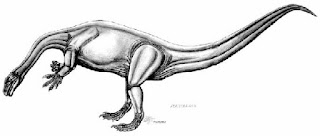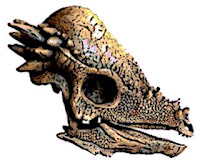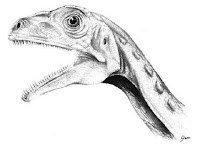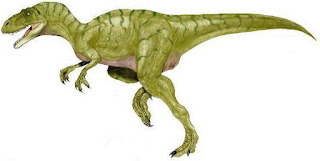Nickname Beat: Dinosaurs
By Matthew Anderson
Microraptor
 |
| Nickname: Microraptor to Shirley from Jennifer |
Microraptor (meaning "little plunderer") is a newly discovered, bird-like dinosaur from China. This crow-sized coelurosaurid theropod was about 16 inches (40 cm long). A partial skeleton (missing the middle portion) and feather-like impressions were found in Liaoning, China. It is probably an adult, but this is not certain. It was named by Xu, Zhou, and Wang in 2000.
Jobaria
 |
| Nickname: Jobaria to Duane from Linda |
Jobaria was named for Jobar, a mythical creature of African legends. It was a long-necked, long-tailed dinosaur. Jobaria was 6 feet wide across its chest. It had one large claw on each front foot, and smaller claws on its hind feet. In 1997, several Jobaria fossils were found together, indicating that this dinosaur was a herding animal.
Datousaurus
 |
| Nickname: Datousaurus to The Scotts from Shirley |
Datousaurus was a long-necked, long-tailed, quadrupedal, plant-eating dinosaur. This solidly built sauropod was over 50 ft (15 m) long. It had 5 toes on each of its four feet. Fossils have been found in China. Its teeth were spoon shaped, and it had a very solid skull (unlike many sauropods).
Brachiosaurus
Brachiosaurus means, "Arm lizard". It used to be thought that the sauropods (like Brachiosaurus and Apatosaurus) and Stegosaurus had a second brain. Brachiosaurus was first found in the Grand River Valley, in western Colorado, USA, in 1900. A few incomplete fossils have been found (mostly without skulls). Unlike most other dinosaurs, the front legs of Brachiosaurus were longer than the hind legs (hence its name, "arm lizard").
Allosaurus
Allosaurus means "Different Lizard". It was the biggest meat-eater in North America. Allosaurus was a powerful predator that walked on two powerful legs, had a strong, S-shaped neck, and had vertebrae that were different from those of other dinosaurs (hence its name, the "different lizard"). An Apatosaurus vertebra was found with Allosaurus tooth marks etched into it, evidence of an Allosaurus attack. The first virtually complete Allosaurus skeleton was discovered by rancher M. P. Felch in 1883, in Colorado, USA.
Largest & Smallest Dinosaurs
A villager from a desolate part of southern Patagonia in Argentina recently found the fossil of what may be the world's biggest-known dinosaur (unnamed). This enormous plant-eater, a sauropod, may have been 157 to 167 feet (48-51 m) long. This behemoth is probably even bigger than Argentinosaurus, another giant plant-eater found nearby.
Compsognathus was a small, meat-eating, bird-like dinosaur that walked on two slender legs. This dinosaur was named by Johann A. Wagner in 1859. It was the size of a chicken and is the smallest-known dinosaur.
Dinosaurs & Birds
God created everything. All the Bible’s miracles occurred quickly, including the biggest and first miracle—creation itself. Birds were created before dinosaurs, reptiles, and other beasts of the earth. (Gen 1:20–25) Man saw and wrote about dinosaurs and giant seagoing reptiles. (Job 40:15–41:34) Life was created during only three of the six creation days—3rd day: plant life, 5th day: sea life and birds, and the 6th day: other land animals and man. (Gen 1) God finished “all His work” in six days. (Gen 2:1–3; Ex 20:11, 31:17; Heb 4:1–11)
The Flood - Hydroplate Theory
There was just one single major earth catastrophe of judgment that caused the near extinction of life, the Genesis flood of Noah's day. There were both volcanic and collision activity associated with the flood. However, the dinosaurs were not driven to extinction at this time. Instead, living dinosaur types were sheltered aboard the Ark. They then gradually disappeared in post-flood centuries due to climate changes and other possible causes.
Archaeopteryx
Archaeopteryx (meaning "ancient wing") was a meat eater. It seemed to be part bird and part dinosaur. Amazingly detailed Archaeopteryx fossils have been found in fine-grained limestone in southern Germany. It was named by the German paleontologist Hermann von Meyer in 1861. Bird fossils are rare because bird bones are hollow and fragile, and usually deteriorate instead of fossilizing.
Iguanodon
Iguanodon means "Iguana Tooth". Iguanodon was a plant-eating dinosaur. Iguanodon was a dinosaur that had a horny, toothless beak and tightly packed cheek teeth. On each hand, Iguanodon had four fingers plus a conical thumb spike on each hand (that was perpendicular to the other fingers). The thumb spikes may have been used for defense or in obtaining food; it ranged from 2 to 6 inches long.
Argentinosaurus
Argentinosaurus means "Argentina lizard". It was a plant-eater and weighed 80 -100 tones. It may be the largest dinosaur. It had a long neck, a long tail, and a small head. Very little is known about this giant dinosaur.
Dinosaurus
 |
| Nickname: Dinosaurus to Gloria from David |
Dinosaurus is pronounced DIEN-oh-SAWR-us. Dinosaurus means, "terrifying lizard." It was a large, plant-eating dinosaur (a plateosaurid prosauropod) that lived in what is now Europe. Dinosaurus was named by Ruetimeyer in 1856. Dinosaurus (later Gresslyosaurus) is probably the same as the genus Plateosaurus.
Baryonyx
 |
| Nickname: Bary to Judy from Linda |
Baryonyx, meaning "Heavy claw", was an unusual theropod dinosaur with huge 1-foot (30.5-cm) long claws on its hands, and long, narrow, crocodile-like jaws with 96 small, serrated teeth (this is 1.5 times the number of teeth that most other theropods had). It had a long, straight neck (unlike other theropods, who had s-shaped necks) and a long tail. Baryonyx was a carnivore. It was a large predator that ate fish. A fossilized Baryonyx was found with a fossilized meal in its stomach; this stomach contained fish scales, fish bones, and some partially digested bones of a young Iguanodon.
Pachycephalosaurus
 |
| Nickname: Pachycephalosaurus to Paul from Dianne |
Pachycephalosaurus means "Thick-Headed Lizard". Its huge head had an incredibly thick skull, a large brain, and large eyes. Pachycephalosaurus grew to be about 15 feet long. Pachycephalosaurus probably had a good sense of smell. Running was probably the first line of self-defense.
Coloradisaurus
 |
| Nickname: Coloradisaurus to Linda from David |
Coloradisaurus means "lizard from the Los Colorados formation" in Argentina. It was perhaps up to 10 to 13 feet long. It had a small head, large eyes, and a large body. Coloradisaurus may be the adult version of Mussaurus. A fossil skull was found in Argentina and was named by paleontologist Lambert in 1983.
Torosaurus
 |
| Nickname: Torosaurus to Julie from Jennifer |
Torosaurus means, "pierced lizard". It was a plant-eater and it may have eaten conifers, cycads, ginkgoes, and flowering plants. The first Torosaurus skull was found by the fossil hunter John Bell Hatcher. Torosaurus' enormous horned skull was 8 feet long. It had a large, bony, neck frill, a short horn on the snout, two long eyebrow horns, and a toothless beak.
Tyrannosaurus Rex
 |
| Nickname: T-Rex to Matthew from Jennifer |
Tyrannosaurus Rex means "Tyrant lizard king". T-Rex's foot was 3.3 feet long. He was 40 feet long. The skin has been described as "lightly pebbled skin". It's arms were 3 feet long.
Maiasaura
 |
| Nickname: Maiasaura to Dianne from Julie |
Maiasaura means "Good Mother Lizard". It was named by Jack R. Homer and Robert Makela in 1979. Maiasaura was a dinosaur with a flat skull and small crests in front of the eyes. It was a duck-billed, plant-eating dinosaur. First one found with its young and first dinosaur in space.
Mussaurus
 |
| Nickname: Mussaurus to David from Jennifer |
Mussaurus means "Mouse Lizard". Mussaurus (pronounced moo-SAWR-us) was a small, plant-eating dinosaur. It is the smallest dinosaur skeletons yet found. No adult Mussaurus fossils have been found. The baby Mussaurus could fit in a person's hand. Its back legs were longer than its front legs.
Megalosaurus
 |
| Nickname: Megalo to Jennifer from Linda |
William Buckland found this dinosaur in England in 1819. The dinosaur footprints are found in limestone in Southern England. It was named in 1824 and at that time the word dinosaur hadn't even been invented. Megalosaursus was a meat eater dinosaur. Megalosaursus means "Great Lizard" and it weighed about 1 ton. It was the first dinosaur scientifically described and named.












No comments:
Post a Comment